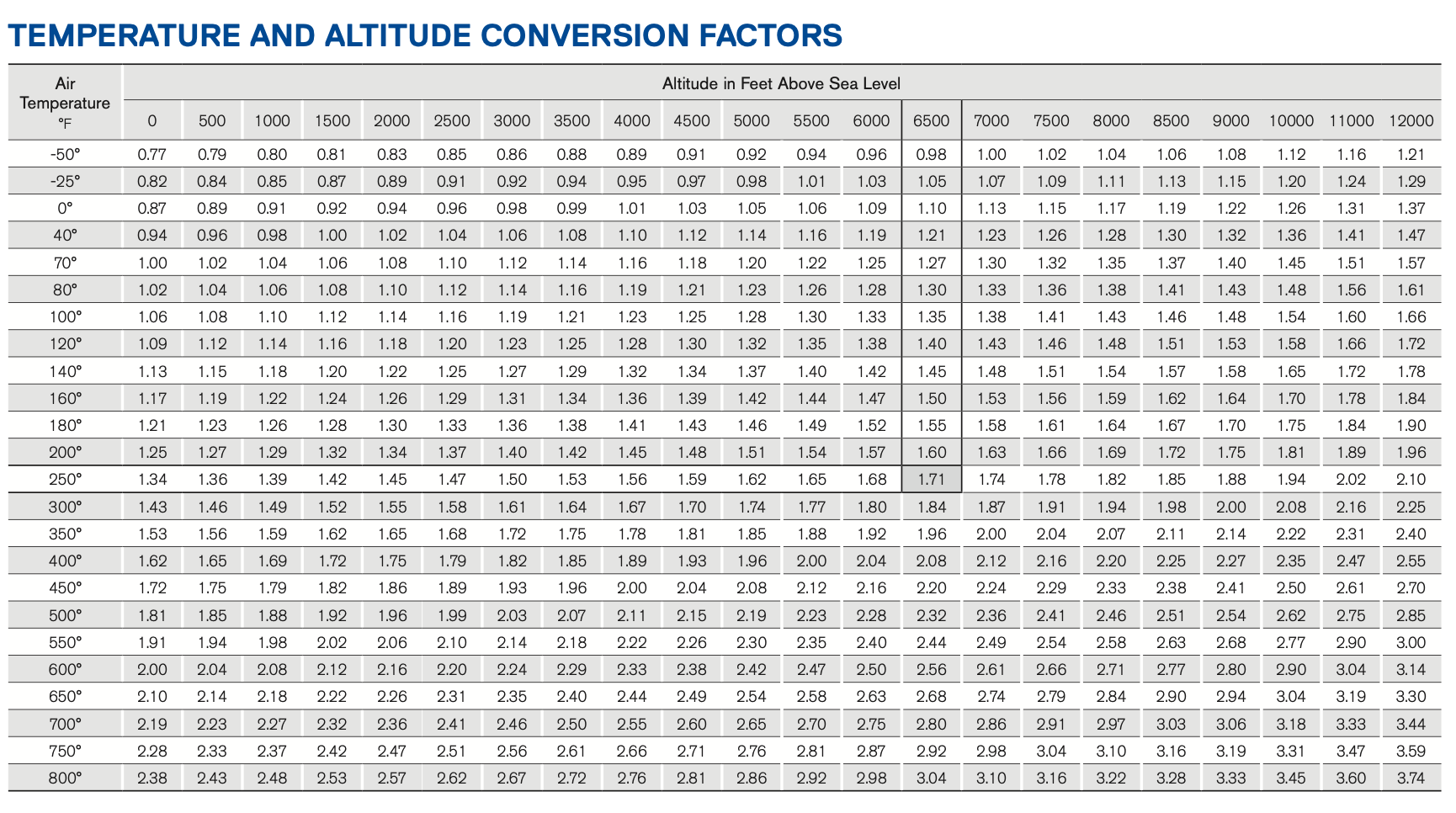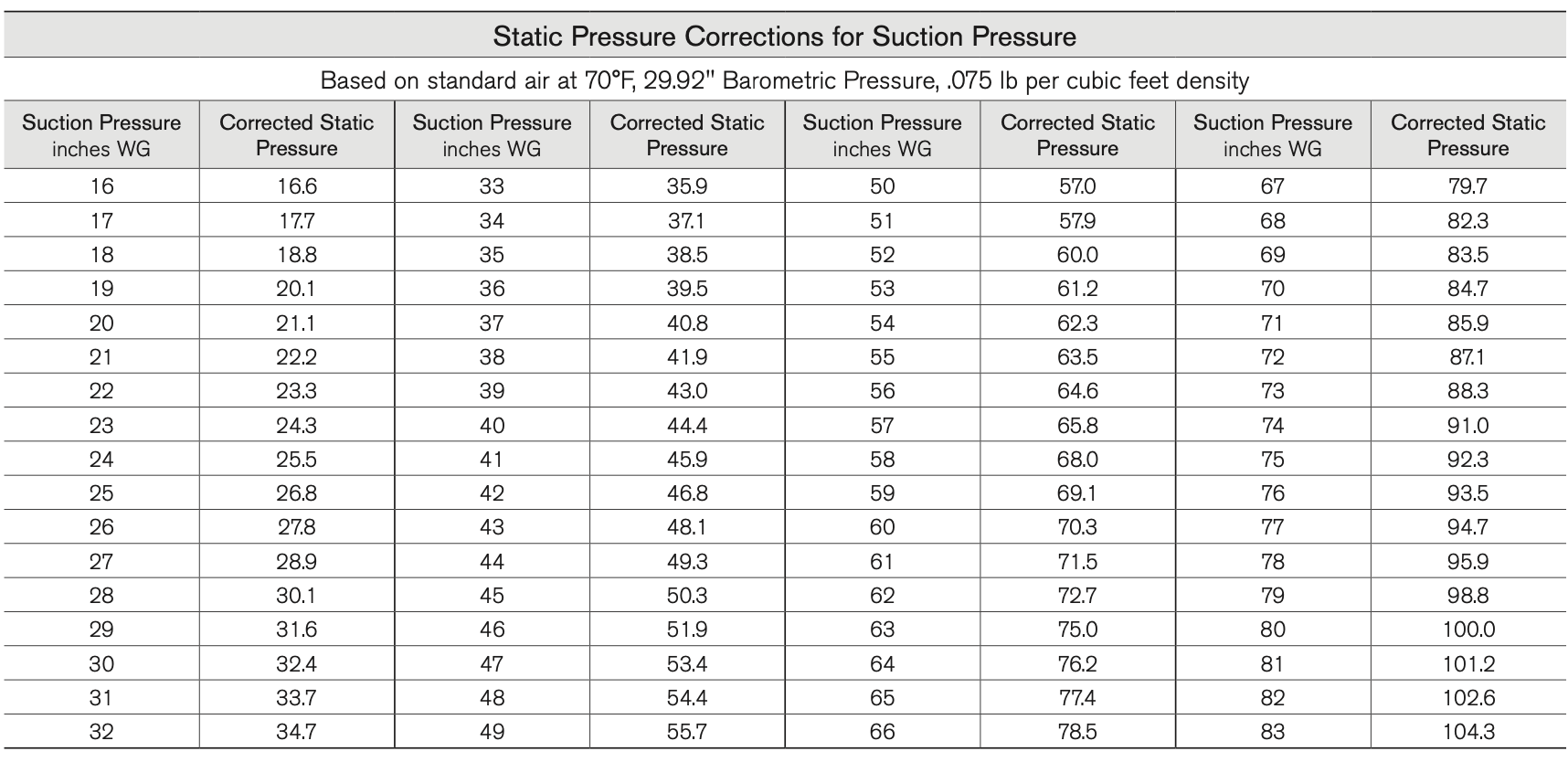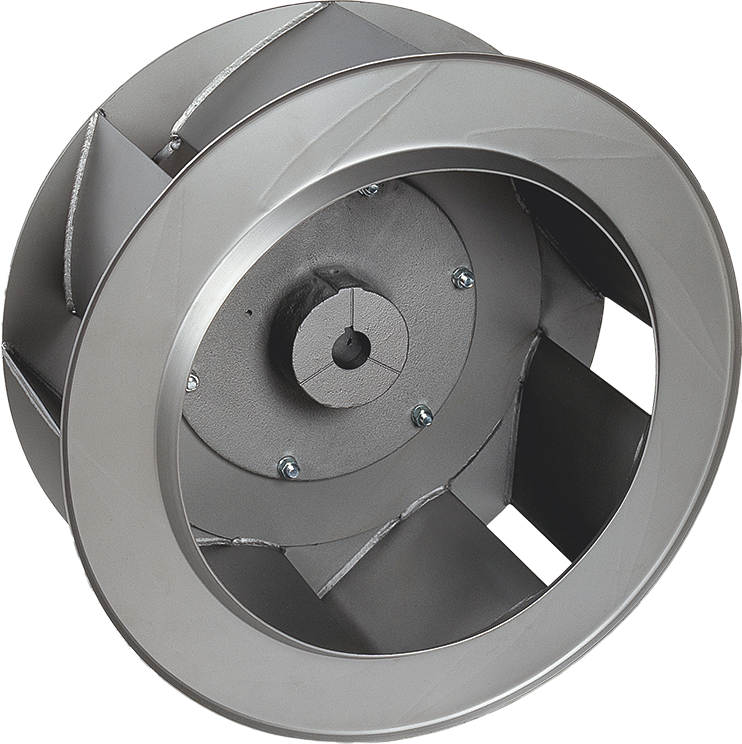To make the proper selection, you should consider the following conditions the fan or blower will be subjected to.
- What is the mounting configuration, if any, of the fan or blower in the system? For a list of configerations (arrangements), see page 3 in our Engineering Data catalog.
- What airflow is required? This is rated in cubic feet of air per minute (CFM) or cubic meters per hour (M³/Hr).
- What is the static pressure through the complete system? This is rated in static pressure water gauge (SPWG) or Pascal’s (Pa). SPWG or Pa is the resistance to flow, or friction, caused by the air moving through a pipe or duct. Be sure to include losses through filters, dampers, etc. NOTE: If the static pressure on the inlet side of the blower will exceed 15” SPWG, a correction for suction pressure (rarefication) should be made. For a definition of rarefication and a suction pressure correction chart, see pages 6 and 7 in our Model HP-II Product Specification.
- What is the ambient air temperature outside the fan or blower?
- What are the airflow conditions through the fan or blower?
- Clean or dirty (contaminated) air?
- Dry or wet (moisture laden) air?
- Temperature of air?
- What is the altitude the fan or blower will be operating at?
- Is anything going through the fan or blower that could be explosive or flammable?
- Does the general location the fan or blower is operating in contain any type of explosive or flammable material or liquid?
- If the fan or blower will be used to convey material, answer the following:
- What is the material?
- How much does the material weigh, in pounds per cubic foot?
- How many pounds will you need to convey per hour?
- Is the material long and stringy or granular?
Most fans and blowers can be used for any of the above parameters except, if conveying material, a centrifugal fan or blower with a forward curve (squirrel cage) wheel and any axial fan with a propeller, is not suitable. The best wheel type for conveying material is a radial wheel or an open radial wheel. If the material you will be conveying is log and stringy, like paper trim or fibers, only an open radial wheel should be used.
If the fan or blower will be used to create suction, pressurization, cooling, combustion air, forced ventilation, exhaust or general ventilation, then only the first eight conditions above need to be considered.
For additional information on how to select an industrial fan or blower, download our Selecting a Fan or Blower manual.
Flow Rate (CFM)
SCFM stands for Standard Cubic Feet per Minute. It is the CFM at standard density, defined as .075 lb/cubic foot.
ACFM stands for Actual Cubic Feet per Minute. It is the CFM at an identified density other than .075 lb/ft3. It is also the required mass flow rate divided by the density of the gas being handled. Since fans and blowers handle the same volume of air regardless of density, the ACFM value (and corresponding density) is the preferred value to use when selecting a fan or blower. Note that ACFM and SCFM are not interchangeable except at .075 lb/ft3 density.
Airflow is rated in cubic feet per minute (CFM) or the metric equivalent, cubic meters per hour (M3/Hr).
1 CFM = 1.6990 x M3/Hr.
If you will be conveying material, make sure you have enough CFM for the duct, pipe or hose size so the material will maintain the required velocity to carry it completely through the system and not settle in the duct, pipe or hose. See the Engineering Data catalog for material conveying velocities.
Static Pressure (SP)
Static Pressure is the resistance to airflow (friction) caused by the air moving through a pipe, duct, hose, filter, hood slots, air control dampers or louvers. Static Pressure is rated in inches water gauge (inWG) or the metric equivalent, millimeters water gauge (mmWG). 1 inWG = 25.4 x mmWG.
Standard air has a density of .075 lb/ft3 and is based on a temperature of 70°F and 29.92″ Hg barometric pressure (sea level). Fan performance tables are based on using standard air. Corrections for density changes resulting from temperature and/or barometric pressure variations, such as higher altitudes, must be made to the static pressure before selecting a fan or blower based on standard performance data. The metric equivalent is in kilograms per cubic meter (kg/m3). lb/ft3 = 16.018 x kg/m3.
The temperature of the air going through the fan or blower will affect the density and performance of the fan or blower. Temperature should be shown in degrees Fahrenheit (°F). The metric equivalent is degrees Centigrade (°C).
°F = 1.8 x °C + 32
If the air temperature will vary, what are the minimum and maximum temperatures?
The altitude the fan or blower will be operating at will also affect the density and performance of the fan or blower. The altitude should be given in feet above sea level. The metric equivalent is meters (m). 1 ft = .30480 x m
Air Temperature Altitude Correction

Chart found on Page 5 of Selecting a Fan or Blower PDF
EXAMPLE:
Select a blower for 1500 CFM at 7″ WG at 250°F. and at 6500 feet elevation.
- STEP 1. From the table above, the conversion factor for 250° and 6500 ft. altitude is 1.71.
- STEP 2. The corrected static pressure is: 7″ WG x 1.71 = 11.97″ inWG at standard conditions. Round off to 12″ WG.
- STEP 3. Select fan, using fan performance tables, for 1500 CFM at 12″ WG.
NOTE: If the suction pressure on the inlet side of a blower will exceed 15″ inWG, a correction for suction pressure (called rarefication) should be made. See chart below.

Chart found on Page 4 of Selecting a Fan or Blower PDF
EXAMPLES:
- With 45″ of suction pressure on the blower inlet and no discharge pressure on the blower discharge, the total static pressure = 50.3″ inWG.
- With 45″ of suction pressure on the inlet and 12″ of discharge pressure on the discharge, the total static pressure = 50.3″+12″ = 62.3″ inWG.
- With 0″ of suction pressure on the inlet and 12″ of discharge pressure, the total static pressure = 12″ inWG. There is no correction required for discharge pressure.
Centrifugal fans or blowers use one of seven types of wheels that are enclosed in a scroll shaped housing. The air enters the fan wheel through the housing inlet, turns 90 degrees and is accelerated radially and exits the fan housing. Centrifugal fans are typically used for lower flows and higher pressures.
Axial fans use a propeller, having two or more blades, to move air in an axial direction through a cylindrical housing or formed orifice panel. Axial fans are typically used for higher flows and lower pressures. Do not use an axial fan to convey material.
FIND YOUR LOCAL SALES REP
Exceptional local support with over 170 experienced sales engineers in 56 offices strategically located across the U.S. and Canada to assist you.
START HERE
